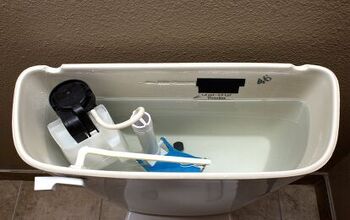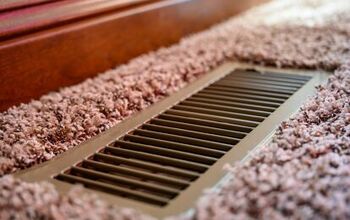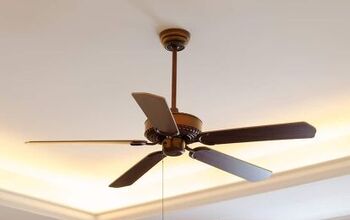Can You Put A Toilet On Top Of A Floating Floor? (Find Out Now!)

Remodeling bathrooms can be tricky. But installing a new toilet shouldn’t be the most challenging part. So, can you put a toilet on top of a floating floor? Or do you need to take extra steps to install it correctly?
Floating floors feature multiple layers – a core and backing for strength and a top layer for looks. However, floating floors sit above the sub-floor. And that means you can’t caulk around the edges because there’s always a gap.
Do You Need to Install or Repair a Toilet?
Get free, zero-commitment quotes from pro contractors near you.

You can install a toilet on top of most floors. But laminate flooring floats on top of the underlayment (or sub-floor). As a result, the space can contract and expand when temperatures and humidity change. And over time, those changes can make your toilet foundation unstable.
Floating floors also complicate caulking. The reason is that there are always gaps between the underlayment and the top layer of flooring. So, caulk will only secure the laminate toilet and not the actual baseboard.
DID YOU KNOW: Installing leaky toilets on top of floating floors can be dangerous because moisture can rot the joists.
Whether you have to remove the toilet to install new floors depends on your bathroom. That’s because some bathrooms feature toilets on separate planes or surrounded by different flooring. For example, most of the space could use vinyl planking, while the area around the toilet uses tiles. So, observe your room. Now, compare that to how you want it to look.
Usually, you have to rip out all of the fixtures to update bathroom flooring. Everything but the bathtub must go, and you must remove even the tub sometimes. Meanwhile, you’ll have to reset the toilet when you get done. Then, correctly install a floating floor material that you can secure to the joists and protect from moisture.
TIP: Disconnect the water supply at your house before removing the toilet or sink.
Can You Put Waterproof Laminate Flooring in a Bathroom?
Traditional laminate can look great, but it doesn’t withstand moisture and waterproof laminate. The latter features a moisture-wicking core that prevents damage from water. That means the waterproof laminate is perfect for basements, kitchens, and bathrooms in most homes.
How Do You Seal Laminate Flooring in a Bathroom?
Laminate flooring can be challenging to caulk. That’s one reason why homeowners prefer not to use laminate flooring in a bathroom. But you can seal laminate floors in any room if you use the correct supplies and process. So, here is what you need to know:
Step 1: Use the Right Flooring
Try to stick with AC3-rated flooring materials because those are the best for long-lasting home remodels.
Step 2: Choose the Best Caulk
Use a 100% silicone caulk when sealing laminate floors. Otherwise, water could leak through the cracks and holes.
Step 3: Apply Caulk Carefully
Leave quarter-inch gaps between caulk beads for expansion because moisture can make components swell.
Next, let the caulk dry and don’t get it wet. Then go back and fill in the remaining gaps with more silicone caulk. And if all else fails, choose a different flooring material. Remember, floating floors and new toilet installations don’t always get along.
Caulking around your toilet helps keep it secure. Caulk also prevents your toilet from moving when the floor joists contract or expand from moisture. So, always caulk around your toilet regardless of which flooring material you choose.
DID YOU KNOW: The International Plumbing Code requires caulk around toilets for safety reasons.
Floating Bathroom Floors: Check
Do You Need to Install or Repair a Toilet?
Get free, zero-commitment quotes from pro contractors near you.

Related Questions
Should You Caulk Baseboards in a Bathroom?
Caulking the baseboards in your bathroom is crucial because there’s a lot of moisture in the room. So, always apply a generous layer of waterproof sealant around every edge and joint. Protect your walls and joists while preventing expansions and contractions. Since water damage can be expensive to fix, use silicone caulk to help keep moisture at bay.
Should Baseboards Touch the Floor?
Most people don’t install carpet in their bathrooms. So, their baseboards almost always touch the floor. However, you have to consider the height of the newly installed flooring. If you use a high-pile carpet, thick tile, or a floating floor, you might have to leave a gap. And in some cases, you may need to fill those gaps with waterproof caulk.
You can install new floors in your bathroom and then hire a plumber to reinstall the toilet on top of it. But expect to spend at least $350 for the service. Some plumbing companies nearby charge even more. Plus, you also have to pay for removing and disposing of old fixtures. And plumbers can add extra costs based on your location as well.
Related Guides

Tiffany Nichols specializes in aesthetics, design, marketing, and manufacturing. She's a copywriter and editor for several home renovation companies in the U.S. and works alongside some of the biggest names in the industry. Her hobbies include architecture, art, mental health, and fashion.
More by Tiffany Nichols














![10 Best Scroll Saws for 2022 [Ultimate Reviews & Buyer's Guide]](https://cdn-fastly.upgradedhome.com/media/2023/07/31/9070684/10-best-scroll-saws-for-2022-ultimate-reviews-buyer-s-guide.jpg?size=350x220)












